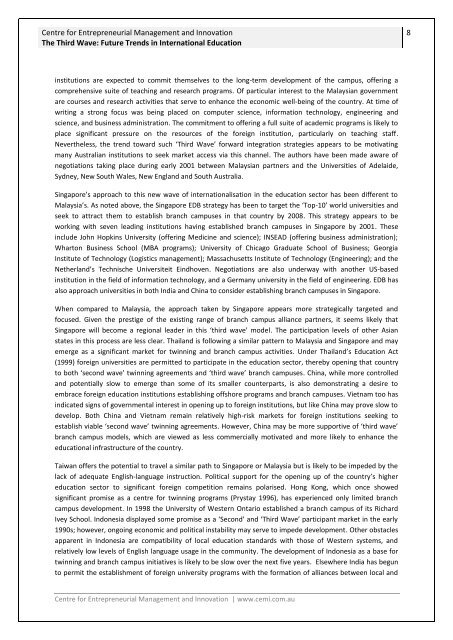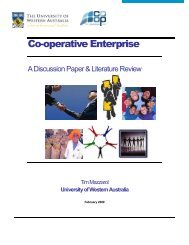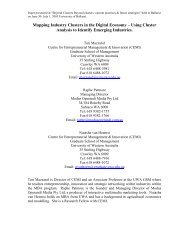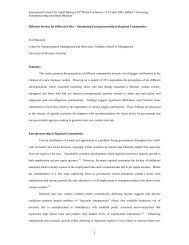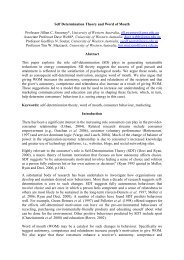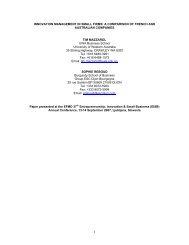The Third Wave: Future Trends in International Education - CEMI
The Third Wave: Future Trends in International Education - CEMI
The Third Wave: Future Trends in International Education - CEMI
You also want an ePaper? Increase the reach of your titles
YUMPU automatically turns print PDFs into web optimized ePapers that Google loves.
Centre for Entrepreneurial Management and Innovation<br />
<strong>The</strong> <strong>Third</strong> <strong>Wave</strong>: <strong>Future</strong> <strong>Trends</strong> <strong>in</strong> <strong>International</strong> <strong>Education</strong><br />
8<br />
<strong>in</strong>stitutions are expected to commit themselves to the long-term development of the campus, offer<strong>in</strong>g a<br />
comprehensive suite of teach<strong>in</strong>g and research programs. Of particular <strong>in</strong>terest to the Malaysian government<br />
are courses and research activities that serve to enhance the economic well-be<strong>in</strong>g of the country. At time of<br />
writ<strong>in</strong>g a strong focus was be<strong>in</strong>g placed on computer science, <strong>in</strong>formation technology, eng<strong>in</strong>eer<strong>in</strong>g and<br />
science, and bus<strong>in</strong>ess adm<strong>in</strong>istration. <strong>The</strong> commitment to offer<strong>in</strong>g a full suite of academic programs is likely to<br />
place significant pressure on the resources of the foreign <strong>in</strong>stitution, particularly on teach<strong>in</strong>g staff.<br />
Nevertheless, the trend toward such ‘<strong>Third</strong> <strong>Wave</strong>’ forward <strong>in</strong>tegration strategies appears to be motivat<strong>in</strong>g<br />
many Australian <strong>in</strong>stitutions to seek market access via this channel. <strong>The</strong> authors have been made aware of<br />
negotiations tak<strong>in</strong>g place dur<strong>in</strong>g early 2001 between Malaysian partners and the Universities of Adelaide,<br />
Sydney, New South Wales, New England and South Australia.<br />
S<strong>in</strong>gapore’s approach to this new wave of <strong>in</strong>ternationalisation <strong>in</strong> the education sector has been different to<br />
Malaysia’s. As noted above, the S<strong>in</strong>gapore EDB strategy has been to target the ‘Top-10’ world universities and<br />
seek to attract them to establish branch campuses <strong>in</strong> that country by 2008. This strategy appears to be<br />
work<strong>in</strong>g with seven lead<strong>in</strong>g <strong>in</strong>stitutions hav<strong>in</strong>g established branch campuses <strong>in</strong> S<strong>in</strong>gapore by 2001. <strong>The</strong>se<br />
<strong>in</strong>clude John Hopk<strong>in</strong>s University (offer<strong>in</strong>g Medic<strong>in</strong>e and science); INSEAD (offer<strong>in</strong>g bus<strong>in</strong>ess adm<strong>in</strong>istration);<br />
Wharton Bus<strong>in</strong>ess School (MBA programs); University of Chicago Graduate School of Bus<strong>in</strong>ess; Georgia<br />
Institute of Technology (Logistics management); Massachusetts Institute of Technology (Eng<strong>in</strong>eer<strong>in</strong>g); and the<br />
Netherland’s Technische Universiteit E<strong>in</strong>dhoven. Negotiations are also underway with another US-based<br />
<strong>in</strong>stitution <strong>in</strong> the field of <strong>in</strong>formation technology, and a Germany university <strong>in</strong> the field of eng<strong>in</strong>eer<strong>in</strong>g. EDB has<br />
also approach universities <strong>in</strong> both India and Ch<strong>in</strong>a to consider establish<strong>in</strong>g branch campuses <strong>in</strong> S<strong>in</strong>gapore.<br />
When compared to Malaysia, the approach taken by S<strong>in</strong>gapore appears more strategically targeted and<br />
focused. Given the prestige of the exist<strong>in</strong>g range of branch campus alliance partners, it seems likely that<br />
S<strong>in</strong>gapore will become a regional leader <strong>in</strong> this ‘third wave’ model. <strong>The</strong> participation levels of other Asian<br />
states <strong>in</strong> this process are less clear. Thailand is follow<strong>in</strong>g a similar pattern to Malaysia and S<strong>in</strong>gapore and may<br />
emerge as a significant market for tw<strong>in</strong>n<strong>in</strong>g and branch campus activities. Under Thailand’s <strong>Education</strong> Act<br />
(1999) foreign universities are permitted to participate <strong>in</strong> the education sector, thereby open<strong>in</strong>g that country<br />
to both ‘second wave’ tw<strong>in</strong>n<strong>in</strong>g agreements and ‘third wave’ branch campuses. Ch<strong>in</strong>a, while more controlled<br />
and potentially slow to emerge than some of its smaller counterparts, is also demonstrat<strong>in</strong>g a desire to<br />
embrace foreign education <strong>in</strong>stitutions establish<strong>in</strong>g offshore programs and branch campuses. Vietnam too has<br />
<strong>in</strong>dicated signs of governmental <strong>in</strong>terest <strong>in</strong> open<strong>in</strong>g up to foreign <strong>in</strong>stitutions, but like Ch<strong>in</strong>a may prove slow to<br />
develop. Both Ch<strong>in</strong>a and Vietnam rema<strong>in</strong> relatively high-risk markets for foreign <strong>in</strong>stitutions seek<strong>in</strong>g to<br />
establish viable ‘second wave’ tw<strong>in</strong>n<strong>in</strong>g agreements. However, Ch<strong>in</strong>a may be more supportive of ‘third wave’<br />
branch campus models, which are viewed as less commercially motivated and more likely to enhance the<br />
educational <strong>in</strong>frastructure of the country.<br />
Taiwan offers the potential to travel a similar path to S<strong>in</strong>gapore or Malaysia but is likely to be impeded by the<br />
lack of adequate English-language <strong>in</strong>struction. Political support for the open<strong>in</strong>g up of the country’s higher<br />
education sector to significant foreign competition rema<strong>in</strong>s polarised. Hong Kong, which once showed<br />
significant promise as a centre for tw<strong>in</strong>n<strong>in</strong>g programs (Prystay 1996), has experienced only limited branch<br />
campus development. In 1998 the University of Western Ontario established a branch campus of its Richard<br />
Ivey School. Indonesia displayed some promise as a ‘Second’ and ‘<strong>Third</strong> <strong>Wave</strong>’ participant market <strong>in</strong> the early<br />
1990s; however, ongo<strong>in</strong>g economic and political <strong>in</strong>stability may serve to impede development. Other obstacles<br />
apparent <strong>in</strong> Indonesia are compatibility of local education standards with those of Western systems, and<br />
relatively low levels of English language usage <strong>in</strong> the community. <strong>The</strong> development of Indonesia as a base for<br />
tw<strong>in</strong>n<strong>in</strong>g and branch campus <strong>in</strong>itiatives is likely to be slow over the next five years. Elsewhere India has begun<br />
to permit the establishment of foreign university programs with the formation of alliances between local and<br />
Centre for Entrepreneurial Management and Innovation | www.cemi.com.au


